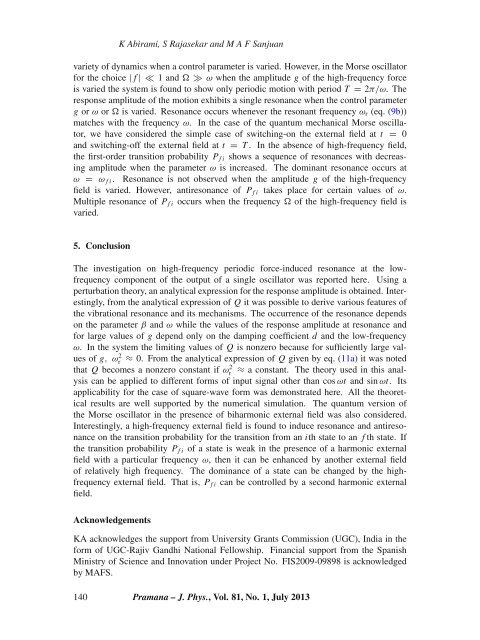Vibrational resonance in the Morse oscillator - Indian Academy of ...
Vibrational resonance in the Morse oscillator - Indian Academy of ...
Vibrational resonance in the Morse oscillator - Indian Academy of ...
Create successful ePaper yourself
Turn your PDF publications into a flip-book with our unique Google optimized e-Paper software.
K Abirami, S Rajasekar and M A F Sanjuan<br />
variety <strong>of</strong> dynamics when a control parameter is varied. However, <strong>in</strong> <strong>the</strong> <strong>Morse</strong> <strong>oscillator</strong><br />
for <strong>the</strong> choice | f |≪1 and ≫ ω when <strong>the</strong> amplitude g <strong>of</strong> <strong>the</strong> high-frequency force<br />
is varied <strong>the</strong> system is found to show only periodic motion with period T = 2π/ω. The<br />
response amplitude <strong>of</strong> <strong>the</strong> motion exhibits a s<strong>in</strong>gle <strong>resonance</strong> when <strong>the</strong> control parameter<br />
g or ω or is varied. Resonance occurs whenever <strong>the</strong> resonant frequency ω r (eq. (9b))<br />
matches with <strong>the</strong> frequency ω. In <strong>the</strong> case <strong>of</strong> <strong>the</strong> quantum mechanical <strong>Morse</strong> <strong>oscillator</strong>,<br />
we have considered <strong>the</strong> simple case <strong>of</strong> switch<strong>in</strong>g-on <strong>the</strong> external field at t = 0<br />
and switch<strong>in</strong>g-<strong>of</strong>f <strong>the</strong> external field at t = T . In <strong>the</strong> absence <strong>of</strong> high-frequency field,<br />
<strong>the</strong> first-order transition probability P fi shows a sequence <strong>of</strong> <strong>resonance</strong>s with decreas<strong>in</strong>g<br />
amplitude when <strong>the</strong> parameter ω is <strong>in</strong>creased. The dom<strong>in</strong>ant <strong>resonance</strong> occurs at<br />
ω = ω fi . Resonance is not observed when <strong>the</strong> amplitude g <strong>of</strong> <strong>the</strong> high-frequency<br />
field is varied. However, anti<strong>resonance</strong> <strong>of</strong> P fi takes place for certa<strong>in</strong> values <strong>of</strong> ω.<br />
Multiple <strong>resonance</strong> <strong>of</strong> P fi occurs when <strong>the</strong> frequency <strong>of</strong> <strong>the</strong> high-frequency field is<br />
varied.<br />
5. Conclusion<br />
The <strong>in</strong>vestigation on high-frequency periodic force-<strong>in</strong>duced <strong>resonance</strong> at <strong>the</strong> lowfrequency<br />
component <strong>of</strong> <strong>the</strong> output <strong>of</strong> a s<strong>in</strong>gle <strong>oscillator</strong> was reported here. Us<strong>in</strong>g a<br />
perturbation <strong>the</strong>ory, an analytical expression for <strong>the</strong> response amplitude is obta<strong>in</strong>ed. Interest<strong>in</strong>gly,<br />
from <strong>the</strong> analytical expression <strong>of</strong> Q it was possible to derive various features <strong>of</strong><br />
<strong>the</strong> vibrational <strong>resonance</strong> and its mechanisms. The occurrence <strong>of</strong> <strong>the</strong> <strong>resonance</strong> depends<br />
on <strong>the</strong> parameter β and ω while <strong>the</strong> values <strong>of</strong> <strong>the</strong> response amplitude at <strong>resonance</strong> and<br />
for large values <strong>of</strong> g depend only on <strong>the</strong> damp<strong>in</strong>g coefficient d and <strong>the</strong> low-frequency<br />
ω. In <strong>the</strong> system <strong>the</strong> limit<strong>in</strong>g values <strong>of</strong> Q is nonzero because for sufficiently large values<br />
<strong>of</strong> g, ωr<br />
2 ≈ 0. From <strong>the</strong> analytical expression <strong>of</strong> Q given by eq. (11a) it was noted<br />
that Q becomes a nonzero constant if ωr<br />
2 ≈ a constant. The <strong>the</strong>ory used <strong>in</strong> this analysis<br />
can be applied to different forms <strong>of</strong> <strong>in</strong>put signal o<strong>the</strong>r than cos ωt and s<strong>in</strong> ωt. Its<br />
applicability for <strong>the</strong> case <strong>of</strong> square-wave form was demonstrated here. All <strong>the</strong> <strong>the</strong>oretical<br />
results are well supported by <strong>the</strong> numerical simulation. The quantum version <strong>of</strong><br />
<strong>the</strong> <strong>Morse</strong> <strong>oscillator</strong> <strong>in</strong> <strong>the</strong> presence <strong>of</strong> biharmonic external field was also considered.<br />
Interest<strong>in</strong>gly, a high-frequency external field is found to <strong>in</strong>duce <strong>resonance</strong> and anti<strong>resonance</strong><br />
on <strong>the</strong> transition probability for <strong>the</strong> transition from an ithstatetoan f th state. If<br />
<strong>the</strong> transition probability P fi <strong>of</strong> a state is weak <strong>in</strong> <strong>the</strong> presence <strong>of</strong> a harmonic external<br />
field with a particular frequency ω, <strong>the</strong>n it can be enhanced by ano<strong>the</strong>r external field<br />
<strong>of</strong> relatively high frequency. The dom<strong>in</strong>ance <strong>of</strong> a state can be changed by <strong>the</strong> highfrequency<br />
external field. That is, P fi can be controlled by a second harmonic external<br />
field.<br />
Acknowledgements<br />
KA acknowledges <strong>the</strong> support from University Grants Commission (UGC), India <strong>in</strong> <strong>the</strong><br />
form <strong>of</strong> UGC-Rajiv Gandhi National Fellowship. F<strong>in</strong>ancial support from <strong>the</strong> Spanish<br />
M<strong>in</strong>istry <strong>of</strong> Science and Innovation under Project No. FIS2009-09898 is acknowledged<br />
by MAFS.<br />
140 Pramana – J. Phys., Vol. 81, No. 1, July 2013
















